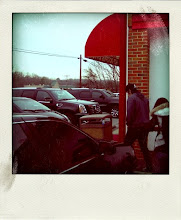Vija Celmins is an artist who focuses on surface and detail, what she describes as "extremely detailed work." Her work is photorealistic and on display at the Metropolitan Museum of Art. In the video, Celmins talked about hating to abandon a work in progress no matter how frustrating or uncertain she may feel about it. I especially liked her painting of the night sky. When you look at it, there is so much depth you feel like you could get lost in it for a long time.
elizabeth murray
Elizabeth Murray is an action painter of "intense color and cartoony shapes." I thought it was interesting that Murray cited William de Kooning as an inspiration because when I saw her work his name came to mind. Murrary also offered the sentiment that "being an artist is one of the most impossible things in the world" and I strongly agree with that statement.
ann hamilton
Ann Hamilton's work was interesting because of the way in which she blended words and new media to create unique art. She represented America in the Venice Biennale, which I thought was interesting because she is not a representational artist. Her piece "Echo" for this show was really intriguing. Also, she named Wallace Stevens as an inspiration and I really like his poetry.
bruce nauman
I wasn't as interested in Bruce Nauman's work as I was in the previous artists. I think this was because the type of art that he creates is so extensive that it's hard to catalogue any of it in such a short segment.
matthew barney
Matthew Barney was intriguing. His Cremaster film seems interesting but I'm not sure that I understand it. Also, I thought it was pretty cool that they shot part of it at the Guggenheim because that architecture is so awesome and unique, which seems to fit Barney's style.



